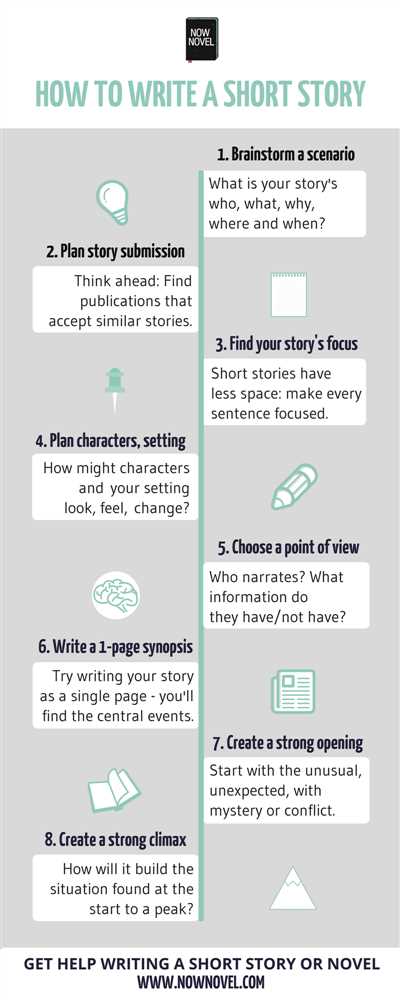
Have you ever wondered how some of the best stories ever written come into existence? Creating a fictional story isn’t as easy as it sounds. It takes careful planning, imagination, and a deep understanding of how to captivate your reader from the very beginning. In this article, we will explore the steps involved in crafting a compelling fictional story, from developing characters to crafting an intriguing plot.
One of the most important parts of any fictional story is the characters. They are the heart and soul of the story, and they need to be memorable and relatable. Take Harry Potter, for example. The boy who lived, orphaned and mistreated by his relatives, captured the hearts of millions of readers around the world. His brave and selfless actions, along with his loyal and quirky friends like Hermione and Ron, made readers eager to know more about their lives.
The beginning of a fictional story is also a significant part. It is where you introduce the main character, setting, and the problem that needs to be solved. Imagine starting your story with a woman named Amy Jasper. The reader doesn’t know much about her, but they can already sense that something significant is about to happen. Will Amy solve a mystery? Will she overcome a personal challenge? The answers to these questions will keep the reader hooked.
As you dive into the writing process, consider the plot of your story. What sequence of events will unfold? How will it all come together in the end? Think about the theme and the actions leading up to the climax. Purdue Owl provides great resources on how to develop a plot and use foreshadowing effectively. Creating a well-structured plot is essential to keep the reader engaged and satisfied with the outcome.
Another important aspect to consider is the description of the world in which your story takes place. From the bustling streets of a city to the mystical landscapes of a magical realm, painting a vivid picture with your words helps the reader immerse themselves in the story. Show them what the characters see, hear, and feel to make the reading experience truly unforgettable.
Finally, don’t underestimate the power of a good title. The name you choose for your fictional story sets the tone and expectations for the reader. It can be mysterious, intriguing, or even playfully cheesy. The title “The Price of Wine” may seem simple but can evoke curiosity and interest. Remember, the best titles are often those that give a glimpse into what awaits the reader within the pages.
In conclusion, creating a fictional story is a challenging yet exhilarating process. From developing your characters to crafting an engaging plot, every step is crucial in making your story come to life. So, grab your pen and paper or let your AI assistant do the work for you, and get ready to embark on an unforgettable journey into the world of fiction!
How to Use Jasper AI to Write Fictional Stories
Creating fictional stories can be an exciting and fulfilling experience for any writer. However, coming up with unique and captivating story ideas can sometimes be a challenge. This is where Jasper AI can help! With its advanced artificial intelligence capabilities, Jasper can provide writers with a wealth of sources and story plots to choose from to help them create their own fictional masterpieces.
When using Jasper AI to write fictional stories, writers have the option to input a specific theme, character name, or even a significant event or action to begin their story. For example, if a writer wants to create a story with a strong female protagonist similar to Hermione from the Harry Potter books, they can simply input “Hermione” as a character name in the AI prompts. Jasper will then generate a line or series of lines to help kickstart the story based on this input.
Jasper AI doesn’t just help writers with initial story ideas – it can also assist throughout the story development process. If a writer gets stuck at a certain point and doesn’t know what should happen next, they can turn to Jasper for guidance. By describing the current situation and asking for suggestions, Jasper can provide writers with various options to consider, helping them to move the story forward.
Another way in which Jasper AI can be useful is by providing writers with descriptions of characters or settings. By asking specific questions about a character’s appearance or personality, writers can get detailed answers that will add depth and complexity to their story. For example, they can ask Jasper to describe the physical features of a man named John Pricewine, and the AI will generate a response with a detailed description.
One of the key benefits of using Jasper AI for writing fictional stories is that it saves time and effort. Writers no longer have to spend hours brainstorming ideas or struggle with writer’s block. Jasper AI can quickly generate unique and interesting storylines, providing writers with a solid foundation to build upon and expand.
However, it is important to note that while Jasper AI can be a helpful tool for writers, it doesn’t replace the creative input and expertise of a human writer. The AI is there to assist and provide suggestions, but the final product will still be a result of the writer’s imagination and vision.
In conclusion, using Jasper AI to write fictional stories can be a great way to spark creativity and develop unique plotlines. With its ability to generate story ideas, provide descriptions, and offer suggestions, Jasper can be a valuable companion for any writer. So, if you’re looking to create fictional stories, give Jasper AI a try – you won’t be disappointed!
Welcome to the Purdue OWL

Are you a writer looking to develop your storytelling skills? Do you want to create fictional stories that captivate readers and keep them coming back for more? Look no further! The Purdue OWL is here to help you become the best writer you can be.
When you write stories, it’s important to use your imagination and create characters that are unique and interesting. One way to do this is by choosing a surname for your character that isn’t too common. For example, instead of naming your character “Amy Smith,” you can go for something more intriguing like “Hermione Jasper.”
But just giving your character a unique name isn’t enough. You need to fully develop them by providing a description of their physical appearance, personality traits, and actions. The actions your characters take throughout the story are what make the plot happen, so it’s crucial to invest time in making them dynamic and leading the story forward.
As a writer, it’s also important to create a strong theme for your story. This theme is the underlying message or lesson that the reader can take away from the story. Without a theme, your story might feel disconnected and lack depth. Theme provides a framework for the events and actions that happen in your story, making it more cohesive.
At the Purdue OWL, we understand that writing fictional stories can be challenging, but we’re here to help. We have provided a wealth of resources and tips for writers like you to navigate the world of storytelling. Our aim is to support and guide you in understanding the key components of a great story, from plot development to character creation.
So, what are you waiting for? Explore the resources provided by the Purdue OWL and start creating your own captivating fictional story. We are glad that you chose us to be a part of your writing journey, and we hope that with our help, you will become the best writer you can be. Thanks for choosing the Purdue OWL!
Create a Leading Character
When it comes to creating a fictional story, the leading character is one of the most significant elements. They are the one who will drive the plot and make things happen in your story. Whether it’s Harry Potter, Hermione Granger, or Amy Smith, the reader will be following their actions and lives throughout the story. Therefore, it is crucial to introduce a strong and memorable character that the reader will be glad to follow.
To begin, consider the theme and plot of your story. Understanding the main events and sequence of the story will help you develop a character that fits well into the narrative. You can start by answering some key questions: Who is this character? What is their name? What are their characteristics? How do they fit into the story’s theme?
When naming your character, choose a name that is memorable and suits the personality and background of the character. For example, if your story is set in a fantasy world, a name like Jasper Pricewine may be more fitting than Amy Smith.
Once you have a name, it’s time to give your character a full description. Describe their appearance, personality traits, and any significant traits or abilities they may have. Consider how they will interact with other characters and how they will play a part in the story’s events.
It is also important to develop your character’s background and their motivations. Why do they act the way they do? What are their goals, desires, and fears? A well-developed character will have depth and will make the story more engaging for the reader.
Remember that a leading character doesn’t have to be perfect. In fact, flaws and challenges make them more relatable and interesting. The reader wants to see the character grow and overcome obstacles throughout the story.
As a writer, it’s important to fully understand your leading character. By doing so, you will be able to write their actions, dialogue, and thoughts in a way that is consistent and true to their character. This will help create a believable and engaging story.
Don’t be afraid to use your imagination and get creative when developing your leading character. The best stories are often those with unique and memorable characters that capture the reader’s attention.
Lastly, make sure that your leading character is essential to the plot. Without their actions and decisions, the story wouldn’t happen or wouldn’t be as interesting. Their choices and development should drive the story forward and keep the reader engaged.
So, when creating a leading character, consider the story’s theme, understand the sequence of events, and develop a character with depth and relatability. Your character will be the driving force behind your story, so put in the time and effort to create a great one. Happy writing!
Develop Your Plot
When it comes to creating a fictional story, developing a strong plot is crucial. The plot is the sequence of events that make up the story and give it structure and purpose. Without a well-developed plot, the story can feel disjointed and the reader may lose interest.
One of the first steps in developing your plot is to decide what your story will be about. You can choose to make the plot centered around a specific event, a character’s journey, or a conflict that needs to be resolved. The plot should have a clear beginning, middle, and end, with each part connecting to the next.
Next, you’ll need to introduce the main characters and their goals. The protagonist is the leading character who will drive the story forward, while the antagonist is the character or force that opposes the protagonist. You can also introduce supporting characters who will play a significant role in the plot.
Once you have established the characters and their goals, it’s time to create the actions and events that will move the story forward. Consider what happens to your characters and how they will react to these events. Will they succeed or fail? How will their experiences shape them and help them grow?
One technique that writers often use to develop their plot is the “What If?” scenario. This involves asking yourself questions like “What if the main character’s sister suddenly disappeared?” or “What if the protagonist had the power to control the weather?”. These “What If?” questions can help you create interesting and unexpected twists in your story.
When making these plot choices, it’s important to keep the reader in mind. Think about what will engage and captivate them. Consider the pacing of your story – is it fast-paced and action-packed, or slow and introspective? The actions and events you choose should move the story forward and keep the reader invested.
Something else to consider is the setting of your story. The setting is where the story takes place and can have a significant impact on the plot. Use vivid descriptions to transport your reader into the world you’ve created and make them feel like they are right there with the characters.
Once you have developed your plot, write an outline or summary of the story. This will help you stay organized and maintain a clear direction as you begin writing.
Remember, creating a strong plot is one of the most important parts of writing a fictional story. The plot is what keeps the reader engaged and wanting to know what happens next. So take the time to develop your plot and you’ll be on your way to creating a captivating story that readers will love.
Writing Help
Creating fictional characters is another essential part of storytelling. Writers can use the characters’ names, descriptions, and actions to develop their personalities. For example, in the Harry Potter books, J.K. Rowling introduces us to Harry, Hermione, and Jasper Pricewine. Each character has their own backstory and lives, leading them to participate in the story’s events.
It is also important to consider the theme of the story. The theme is the underlying message or moral of the story. Writers can choose to make the theme explicit or leave it open for interpretation. Either way, the theme will help guide the writer’s choices in the story’s development.
Thanks to the contributions of Purdue Owl, writers can find helpful resources and tips to improve their writing skills. These resources provide guidance on character development, plot structure, and much more. By using these sources and understanding the basics of storytelling, writers can create engaging fictional stories that captivate their readers.
Sources
When creating a fictional story, it’s important to know that there are many sources you can use to help you along the way. One of the best sources you can use is books. Books introduce you to different characters, plots, and themes that you can incorporate into your own story. For example, the Harry Potter series by J.K. Rowling is a great source of inspiration for many writers. The character Hermione Granger, for instance, is a strong and intelligent woman who plays a significant role in the story. This is just one example of how books can help you in creating your fictional story.
Another source that can be really helpful is AI. AI, or artificial intelligence, can assist writers in generating ideas for a story. AI can suggest possible plot lines, characters, and even provide a full description of a character based on a given name. For example, an AI-generated character named Amy Pricewine could be described as a witty and adventurous woman who is always helping others. AI can be a valuable tool when it comes to creating a fictional story.
In addition to books and AI, another source that can contribute to your story is your own imagination. You don’t always need external sources to create a great story. Sometimes all you need is your own creativity and imagination. Start with a simple idea or concept and let your imagination take over. As you begin to develop your story, you can consider what actions will happen and how the characters will respond to those actions. This is where your own contributions to the story’s plot will come into play.
Finally, don’t forget about the power of research. Research can help you make your story more believable and realistic. For example, if your story is set in a specific time period or location, research can help you accurately depict the details of that time or place. This attention to detail can make your story more immersive and engaging for your readers.
In conclusion, there are many sources you can use when creating a fictional story. Books, AI, your imagination, and research can all play a significant role in helping you develop a unique and compelling story. So don’t be afraid to explore different sources and let your creativity run wild. Happy writing!









